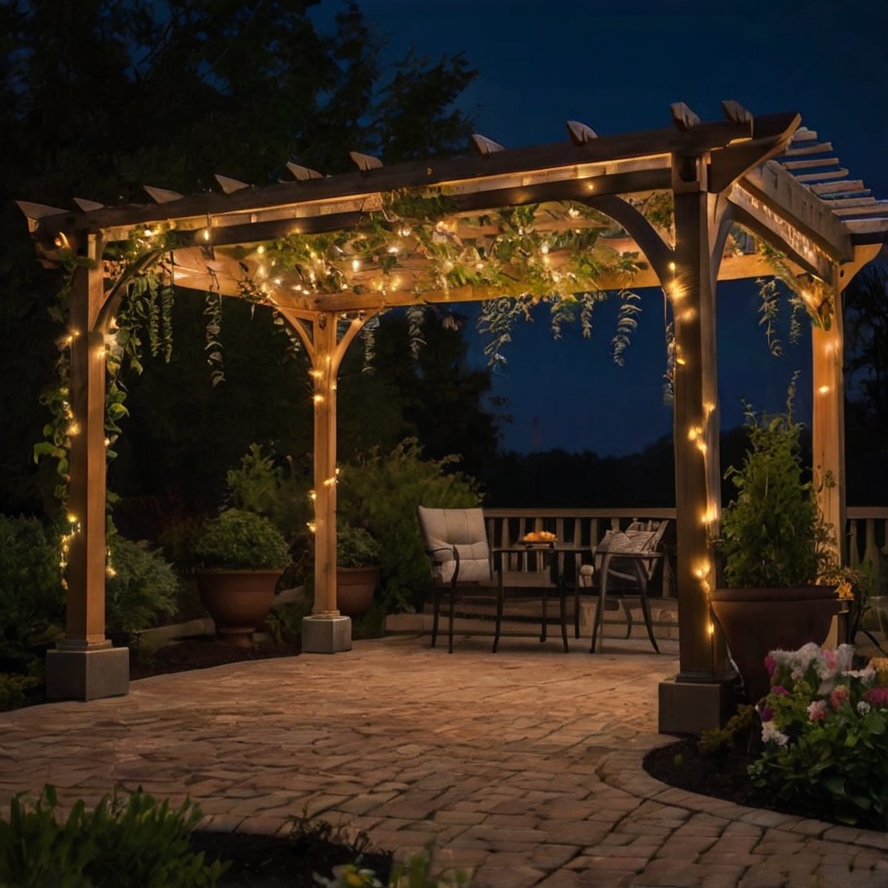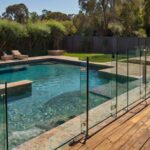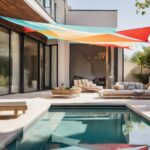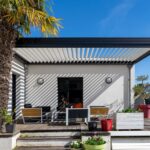Planning outdoor pergola lighting in Australia is a bit different to doing it in, say, Surrey or Seattle. Our sun is harsher, the coast can chew through cheap fittings, and summer BBQs often run late into warm evenings. The right lighting plan turns your pergola into an all‑season zone, safe for cooking, flattering for guests, and effortless to live with. Below, you’ll find practical outdoor pergola lighting ideas in Australia that balance style with standards, so you can get it right the first time.
To understand what homeowners are really asking for in 2025, we spoke with Matt from Bice Electrical, a licensed electrician based in Adelaide who specialises in lighting installs. Matt shared the top pergola lighting trends he’s seeing across Australian backyards right now:
Q: Matt, what’s the biggest shift you’ve noticed in outdoor pergola lighting?
A lot of clients are moving away from single “all-purpose” fittings. Instead, they want layered lighting – festoon strings or pendants for atmosphere, a focused strip or spotlight for the BBQ, and subtle accents on surrounding plants or posts. It’s about zones and flexibility rather than flooding the whole area with one big light.
Q: What about durability – are materials and IP ratings a concern?
Absolutely. In Australia, the sun and coastal air are brutal on cheap fittings. We recommend marine-grade stainless or quality powder-coated aluminium, and always check the IP rating. Even under a pergola roof, you want at least IP44, and for edges or garden lights you should go higher. A lot of people are learning the hard way that “indoor pendants” won’t last outside.
Q: Are people asking for smart lighting features?
Yes, dimmers and smart controls are huge. Clients love being able to hit a “BBQ” scene for brighter task lights, then dim everything back to warm festoons for after-dinner drinks. Motion sensors on steps are also popular for safety without needing to leave them on all night. But I always tell people – keep your essential task lighting on a simple switch, so it works even if the Wi-Fi drops out.
Q: Any common mistakes you’d warn homeowners about?
Two things. First, mixing colour temperatures – if half your pergola is cool white and half is warm, it looks odd. Stick within a narrow band. Second, under-planning power. People add a bar fridge, a fan, festoons, and suddenly one GPO isn’t enough. We always map out circuits properly at the start to avoid messy extensions later.
Plan For Australian Conditions
Climate And Coastal Corrosion
Australia throws the lot at outdoor lights: UV, heat, sudden downpours, and, around much of the coast, salt spray. Choose materials and finishes that actually last.
Prefer marine‑grade 316 stainless, powder‑coated aluminium with quality pre‑treatment, or solid brass/copper (they patina, not peel).
Avoid cheap galvanized and thin chrome finishes near the coast, salt will find every weakness.
Look for UV‑stabilized cables and seals. Clear acrylic lenses yellow over time: glass or UV‑stabilized polycarbonate holds up better.
If you’re rural or inland, dust and insects are the enemy, pick enclosed, easy‑to‑clean fittings.
Tip: Mount fittings with a small standoff from timber beams to allow airflow and reduce trapped moisture. A dab of anti‑seize on screws saves swearing later.
Safety, Licensing, And IP Ratings
Australia’s wiring rules (AS/NZS 3000) mean anything hard‑wired needs a licensed electrician. It’s non‑negotiable, and protects you if something goes wrong.
Use weatherproof outdoor GPOs (at least IP56) under the pergola roof for plug‑in festoons or transformers.
Pick fittings rated for the exposure:
Under cover, low splash: IP44–IP54.
Exposed edges and rain: IP65.
Ground uplights or garden beds: IP67 (temporary immersion resistance).
Ensure RCD protection on outdoor circuits. In older homes, ask your sparky to check and add it if missing.
Look for SAA/RCM compliance markings: avoid no‑name imports with dubious approvals.
A quick rule: if water can get there, step up the IP rating. If salt can get there, step up the material quality.
Layer Your Light: Ambient, Task, Accent
A good pergola scheme uses layers. Ambient light sets the mood, task light keeps you safe and precise, and accent light gives you the wow.
Ambient: Festoons, Pendants, And Lanterns
Ambient lighting is your base layer, the glow that makes the space feel welcoming.
Festoons: Classic for Aussie summers. Choose heavy‑duty rubber cable, E27 LED globes, and weatherproof sockets. Drape in gentle scallops or zig‑zags across rafters for even spread. Warm white (2200–2700K) feels relaxed and helps mozzies stay less interested.
Pendants: Over a dining table, a pair of outdoor‑rated pendants anchors the space. Use open baskets or glass shades that don’t trap insects. Ensure the canopy and cord are outdoor‑rated and protected from rain.
Lanterns/Wall lights: On posts or adjoining walls, they fill corners and help the pergola blend with the house façade.
Keep ambient brightness modest. You want a glow, not a car park.
Task: BBQs, Benchtops, And Steps
Task lighting is bright, directional, and out of your eyes.
BBQs: Mount a slimline under‑beam LED bar or adjustable spotlight above and slightly behind the cook, aimed to avoid shadows. Neutral white (3000–3500K) shows meat doneness accurately.
Benchtops/Sinks: Underslung LED strip beneath a shelf or overhead beam gives even, shadow‑free prep light. Specify outdoor‑rated LED tape (IP65 or IP67) in an aluminium channel with a diffuser.
Steps/Edges: Low‑glare step lights or tiny recessed markers reduce trips. Space them 1.2–1.5 m apart or every second tread depending on width.
Add a separate switch for task zones so you’re not stuck with full brightness during drinks.
Accent: Uplights, Strips, And Feature Plants
Accent light adds dimension and drama.
Uplights: Aim at stone, brick piers, or a textured fence to create depth. For trees near the pergola, a 4–6 W 12/24V spike light angled up the trunk looks magic.
Linear grazers: A concealed strip along the top of a beam can skim light across slats, emphasizing timber grain.
Feature plants: Backlight grasses or sculptural natives (gymea lilies, grass trees) for silhouettes that play beautifully at night.
Rule of thumb: accent lights should be subtler than task lighting but brighter than the ambient glow right where they land.
Fixture And Control Ideas
Solar And Low-Voltage Options
If running new mains power is tricky, solar and low‑voltage systems are your friends.
Solar: Good for path markers and gentle ambience, less ideal for high‑output task light. Choose models with replaceable batteries and panels you can angle toward the sun, especially important in winter.
12/24V Low‑voltage: Safe, flexible, and perfect for DIY placement of garden spikes, step lights, and LED strips. Keep driver/transformer in a dry, ventilated location (IP65 minimum if exposed). Use tinned copper cable in coastal areas to slow corrosion.
Mixing is fine: a mains‑powered pendant over the table, 12V spikes in the garden, and solar markers along the path.
Smart Timers, Dimmers, And Sensors
Controls are where liveability happens.
Timers/photocells: Set ambient lights to turn on at dusk and off at a set hour. You get consistency without thinking about it.
Dimmers: Essential for ambience. Use compatible dimmable LEDs and outdoor‑rated dimmers. For strips, consider PWM controllers designed for exterior use.
Motion sensors: Great for steps and access paths, lights up when you carry trays or the bin. Choose adjustable sensitivity to avoid false triggers from possums.
Smart ecosystems: Zigbee/Z‑Wave or Wi‑Fi controllers let you group scenes (Dinner, BBQ, Late‑night). Just ensure strong outdoor Wi‑Fi and weather‑protected modules. If in doubt, keep critical task lighting on a simple, reliable switch.
Layouts, Brightness, And Colour
How Many Lumens And What Kelvin?
Pick brightness and colour temperature to match mood and tasks.
Ambient: 10–20 lumens per square metre as a base glow. For a 16 m² pergola, that’s roughly 160–320 total lumens spread across festoons or lanterns. Warm white 2200–2700K feels relaxed and flattering.
Dining table pendants: 400–800 lumens each depending on shade and height. Warm (2700–3000K).
BBQ/task: 100–200 lux on the grill and bench. Practically, a focused 800–1200‑lumen fitting aimed well usually does it. Neutral 3000–3500K keeps colour rendering natural.
Steps/path: 50–100 lumens per fitting, spaced along the run. Warmer colour (2700–3000K) reduces glare.
If you’re picky about colour, choose CRI 90+ LEDs, food and timber tones look better.
Example Layouts For Small And Large Pergolas
Small pergola (3 × 3 m, coastal):
Ambient: One 10 m heavy‑duty festoon looped in two scallops, 1.8–2.2 m drop from rafters. 2–3 W LED globes, 2200–2700K.
Task: One slim IP65 LED bar above the BBQ at 30–45° angle: one 12V strip under a shelf for prep.
Accent: Two IP67 mini uplights at the base of a feature screen: one spike light on the nearest grass tree.
Controls: Photocell + timer for festoons: separate switch/dimmer for bar/strip.
Materials: 316 stainless fixings, UV‑stabilised cable ties. Keep fittings slightly inboard to reduce salt exposure.
Large pergola (5 × 6 m, suburban):
Ambient: Two outdoor pendants centred over the dining table, plus a perimeter of dimmable wall lanterns on the posts.
Task: Pair of adjustable spotlights on a cross‑beam aimed at the BBQ and pizza oven: step lights on the two‑tread change of level.
Accent: Continuous LED strip in an aluminium channel grazing a brick feature wall: three 24V spike lights washing mature shrubs beyond the pergola for depth.
Controls: Three circuits, Ambient (dimmable), Task (on/off), Accent (dimmable). Optional smart scene control.
Cable: Run conduits neatly along beams: keep joins in accessible, sealed junction boxes.
Budget, Maintenance, And Mistakes To Avoid
Spend Where It Matters (And What To Skip)
Spend on:
Quality exterior‑rated fittings and stainless/brass hardware, cheaper to buy once than replace every summer.
Dimmers and sensible switching. Control is what makes lights feel premium.
A licensed electrician for mains work and tidy cabling. Safety aside, neat installs last longer.
Save/skip:
Over‑spec lumens. Better aiming and optics beat brute brightness.
Mixing too many styles. Two or three coordinated finishes is enough.
Decorative bulbs with no weather rating. Use outdoor‑rated filament LEDs instead.
Cleaning, UV Care, And Rust Prevention
Quarterly wipe‑downs with fresh water (especially coastal) remove salt and pollen. Dry metal parts: don’t leave water spots on stainless.
A tiny smear of dielectric grease on festoon lamp seals keeps moisture out.
Re‑apply protective wax or corrosion inhibitor to stainless/brass as needed.
Check cable ties and mounts annually, UV makes cheap plastics brittle: use UV‑rated ties from the start.
Clear insect debris from vents and diffusers to maintain brightness and lifespan.
Common mistakes to dodge:
Glare bombs: Bare, bright globes at eye level ruin the vibe. Use diffusers, lower wattage, or dim.
One switch for everything: You’ll either over‑light or under‑light. Split ambient, task, and accent.
Mismatched colour temps: Keep within a 300K band across the pergola for a cohesive look.
Under‑planning power: Not enough GPOs or poor transformer placement leads to messy cables.
Ignoring water paths: Fittings under gutters or drip lines fail early. Shift them or add small drip flashings.
Conclusion
Design your pergola lighting for Australia’s reality, sun, salt, storms, and you’ll enjoy it for years. Start with durable materials and correct IP ratings. Layer ambient, task, and accent light so the space works for dinner, cooking, and late‑night chats. Choose low‑voltage or solar where it makes sense, and add smart controls so the whole thing just… happens. Most of all, aim for comfortable, glare‑free warmth. With the right plan, your outdoor pergola becomes the best “room” in the house, no walls required.
Frequently Asked Questions
What are the best outdoor pergola lighting ideas in Australia?
Layer your lighting: ambient (festoons, pendants), task (BBQ and benchtop lights), and accent (uplights, linear grazers, backlit plants). Choose durable materials like 316 stainless, powder‑coated aluminium, or brass, and match IP ratings to exposure. These outdoor pergola lighting ideas in Australia balance mood, safety, and longevity.
What IP rating do I need for pergola lighting in Australia?
Under cover with low splash, use IP44–IP54. For exposed edges or rain, choose IP65. Ground uplights and garden beds need IP67. As a rule: if water can reach a fitting, step up the IP rating. For outdoor pergola lighting in Australia, also confirm SAA/RCM compliance and RCD protection.
How many lumens and what colour temperature suit a pergola?
Ambient: 10–20 lm/m² (e.g., 160–320 lumens for 16 m²) in warm white 2200–2700K. Pendants over dining: 400–800 lumens each at 2700–3000K. BBQ/task: focus 800–1200 lumens, 3000–3500K. Steps/paths: 50–100 lumens per fitting, warmer tones to reduce glare. Aim for CRI 90+ if you’re picky.
Can I install outdoor pergola lights myself in Australia?
Hard‑wired work must be done by a licensed electrician under AS/NZS 3000. You can usually DIY low‑voltage (12/24V) and solar, but use outdoor‑rated gear and keep drivers in dry, ventilated spots. Ensure outdoor circuits have RCD protection and look for SAA/RCM markings on all fittings and controls.
Do warm white lights attract fewer insects around a pergola?
Yes. In general, warmer colour temperatures (around 2200–2700K) and amber tones attract fewer insects than cool, blue‑rich light. Choose LEDs with minimal UV output, use diffusers or shades to reduce glare, and place fittings away from seating to keep bugs focused elsewhere while preserving ambience.
Do I need council approval for pergola lighting in Australia?
Most lighting upgrades don’t require council approval, but all electrical work must comply with regulations and be completed by a licensed electrician. Heritage overlays, strata by‑laws, or significant exterior changes (e.g., new wiring routes or visible fixtures) may need approval. Check your local council and building manager before starting.





